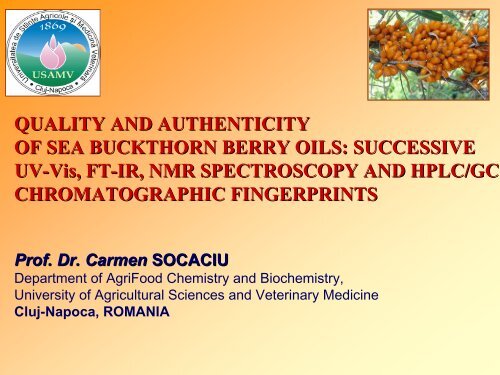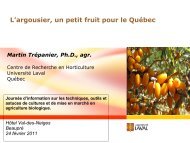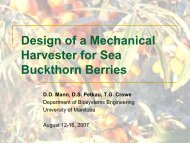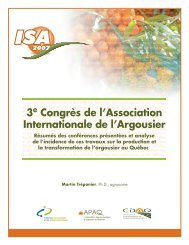QUALITY AND AUTHENTICITY OF SEA BUCKTHORN BERRY OILS ...
QUALITY AND AUTHENTICITY OF SEA BUCKTHORN BERRY OILS ...
QUALITY AND AUTHENTICITY OF SEA BUCKTHORN BERRY OILS ...
Create successful ePaper yourself
Turn your PDF publications into a flip-book with our unique Google optimized e-Paper software.
Aims and objectives‣To find appropriate/advanced analytical methods to evaluate the quality andauthenticity of different SB oils obtained by traditional vs new procedures‣To check the stability of free or encapsulated formulations, after controlledthermal or UV treatments‣To identify the best biomarkers to fingerprint the SB oil qualityand identification of adulteration with cheaper oils (mainly SF)‣To select the best accuracy/price ratios for each method and their limitationsBIOMARKERS ( phytochemicals)Fatty acidsPhytosterolsTocopherolsCarotenoids and chlorophyllsPhenolics…and Oxidation derivatives (peroxides)
Oleosomes: SB oil storage bodies in berriesSocaciu et al., 2001-2006Beveridge et al, 2001
SB oils treatments and formulations1. Thermal treatment (105ºC, 1 h and 10 hrs)2. Irradiation, 1,2,4,6 hrs with UV ( 190 nm)3. Adulteration with SF oil4. Emulsifying capacity O/W5. Encapsulation inalginate and chitosanAims:‣Evaluation of stability in allsituations‣release rate from capsules,‣identification of adulterationmarkers
Methods appliedSPECTROMETRYUV-VisFT-MIR (ATR)NMR( 1 H and 13 C)CHROMATROGRAPHYTLC/HPTLCHPLC-PDAHPLC-UVLC-MSGC-FID
UV-VisVis Spectrometry: fingerprint and stability studies‣Rapid identification/quantification of carotenoids, chlorophyls (Chl), phenolics,in polar (EtOH) and non-polar (PE) solvents‣Discrimination between SBVO and SBO, identification of adulteration with SFO‣Reveals good stability of SBO and SBVO at 105º C and UV-6 hrs‣Easy to do, cheap1Limits: no proper individual identificationsAbsorbance3,00E+002,50E+002,00E+001,50E+001,00E+005,00E-01lipids260phenolics455SB-VOcarotenoids0.80.6Abs0.40.2SB-VO0200 400 600750Wavelength [nm]Abs1.91.51SFOChl0,00E+00200 300 400 500 600Wavelength (nm)0.5-0.1200 300 400500Wavelength [nm]
GC-FID fingerprint of TFASBOSBVO – more rich in C18:1 and C18:2ω 3ω 6SF<strong>OF</strong>atty acidSFO%SBO%14:0 0 0,4616:0 8,02 32,2716:1 0,01 25,4618:0 2,63 0,8118:1 17,70 23,3118:1 cis 0,66 7,4518:2 70,63 6,9718:3 0,30 3,0520:0 0,02 0,1520:1 0,03 0,07
GC-FID Phytosterols fingerprintSterols Retention times (Rt) mg / 100 g oilIS 5α- cholestane-3β- ol 13.751MAJOR STEROLS in SBO/SFO1 Campesterol 16.112 13.533 β-Sitosterol 18.877 610.2334 Δ5-Avenasterol 19.462 73.7816 Cycloartenol 21.305 40.0547 24-Methylenecycloartanol 23.521 37.2015 α-Amyrin 21.173 23.6788 Citrostadienol 25.402 23.365MINOR STEROLSClerosterol 18.011 5.289Campestanol 16.587 tracesStigmasterol 17.6 tracesTOTAL 815.117
HPLC-MS tocopherols and tocotrienolsSBOα-tocopherolβ- tocopherolγ- tocopherol∆- tocopherolTotaltocopherolsα-tocotrienolγ - tocotrienol∆- tocotrienolSBO917.24836Traces953.2 ppmTocotrienols20.721.63.8Total tocotrienols 46.1 ppm 0SFO5956.2721.6411.07633.98 ppm000SBVO:more rich in tocopherols than SBOEasy to identify adulteration with SFO(no tocotrienols)Degradation of tocopherols (15-25%)by thermal/UV treatments / irradiationTocopherols=good markers of quality
HPLC Carotenoid fingerprintSBO-rawEsters of zeaxanthin (4) and cryptoxanthin (5)ZEASBO-saponifiedLUTCRX LYCBC
FT-MIR ( ATR)Sea buckthorn oil (cm –1 ) Assignments streaching1464,76 -C-H (CH 2, CH 3) bending (scissoring)1418,01 =C–H (cis-) bending (rocking)1401,53 bending1377,80 -C-H (CH 3) bending (sym)1321,29 bending1236,86 -C-O, -CH 2- stretching, bending1160,74 -C-O, -CH 2- stretching, bending1117,23 -C-O stretching1097,21 -C-O stretching1031,36 -C-O stretching961,62 -HC=CH- (trans-) bending of planeSBOSBOSFO
FT-MIR: Thermal and UV stabilityA. SBOB. SBO 6h UV,C. SBO 105°C, 10 hrsGood stability after treatments:no peroxides increase ( 3480 cm -1 )Better stability of oil releasedfrom capsulesSocaciu et al., 2007
Controlled adulteration with SFO ( 25%)Oil A2853/A3483 A2853/3006 A2853/1163 A2853/1119 A2853/967SFO 54.8120 4.9405 0.8805 1.6630 5.4009SBO 16.6700 8.9009 0.9748 1.7050 5.5080SBO T 16.1440 8.9000 0.9650 1.7100 5.5200SBO UV 16.0440 8.8010 0.9700 1.7022 5.5265SBVO 16.7905 8.9009 0.9560 1.6890 5.5090
NMR- 1 H applied for oil fingerprintingPowerful (but expensive)method• Recognition ofspecific FA groups• Authentication ofoils• Identification ofadulterated oils• Recognition ofoxidation products(5.4-7 ppm and 8-9ppm)Guillen et al., 2003Guillen and Ruiz, 2005
NMR- 1 H: Controlled adulteration with SFO (25%)SBOSFOEst.Glyceryl groupshiftSBO + SFO
NMR- 1 H: Thermal and UV stabilityNMR- 1 H: SBONMR- 1 H SBO – 105ºC, 10 hrsNMR- 1 H SBO – UV 6 hrs
NMR- 13 C: Controlled adulteration with SFO ( 25%)SBOSFOSBO + SFO
NMR- 13 C: Thermal and UV stabilityNMR- 13 C: SBONMR- 13 C: SBO-105ºC, 10hrsNMR- 13 C: SBO, UV 6 hrs
CONCLUSION (I) We identified 6 types of biomarkers appropriate for SBfingerprint and authenticity: FAs, tocopherols, sterols,carotenoids, phenolics SBVO obtained by protective techniques proved to be rich intocopherols & tocotrienols and MUFAs vs SBO Thermal and UV treatments did not induced drasticdegradations of biomarkers, more affected being tocopherols,carotenoids and MUFAs (< 20%) Microencapsulation provide better stability of oil and can berecommended for internal use of SBVOComparing the composition of SBO and SFO, we identifiedthe relevant markers useful to recognize and quantify theadulteration of SBO with SFO
CONCLUSION (II)‣We used both spectroscopic and chromatographic methodswith different performances:UV-Vis, TLC, FT-MIR, HPLC-PDA, LC-MS, GC-FID, NMR.‣We propose a minimal battery of tests to evaluate the qualityand authenticity of SBO using UV-Vis + TLC+ FT-MIR‣For detailed metabolomic studies and accurate quantitationHPLC and GC can be added as accurate techniques‣NMR can be used as a sensitive method to identify oxidationproducts, provided their previous separation andconcentrationOur studies contribute generally to theoptimization of analytical systems applied in food metabolomics- authenticity - safety
Relevant Publications‣ Pintea, A., et al, 2001. Polar lipids and fatty acid distribution in carotenoproteincomplexes extracted from Sea Buckthorn fruit, Phytochem. Analysis, 12, 293-298.‣ Socaciu, C., Noke, A. 2003.Development of new cosmetic products derived fromcarotenoid-lipoprotein complexes of Sea Buckthorn fruits, Proc.1st Cong. ISAInt Sea Buckthorn Association, Berlin, 65-69‣ Pintea, A., Varga, A., Socaciu, C. 2004. Carotenoids in different hybrids of Seabuckthorn berries, Pigments in Food, more than colours. In: Dufosse L.(ed.),Pigments more than food colors, Conf. Proc. 387-389, Quimper‣ Pintea A., et al., 2005. Chromatographic analysis of Carotenol Fatty Acids Estersin Physalis alkekengi and Hippophae rhamnoides. Phytochem.Analysis. 16: 188‣ Socaciu, C. and Pintea, A. 2006. Molecular composition of carotenoid-Lipoprotein structures of Seabuckthorn (Hippophae rhamnoides L.) Berries, in:V.Singh (ed.), Seabuckthorn (Hippophae L.): A Multipurpose Wonder Plant, Vol.II:Biochemistry and Pharmacology, Daya Pub., Delhi, 605 pp.,‣ Socaciu, C. et. al, Oleosome fractions separated from sea buckthorn berries: yieldand stability studies,in: Seabuckthorn (Hippophae L.): A Multipurpose WonderPlant, Vol.III, 2007 International EU projectsFP5 CRAFT 2001-2005 : <strong>SEA</strong>BUCK Innovative products from fruits of SB National RO projects: 3 Collaboration with industry ( SME) and farms
USAMV Cluj-Napoca, Romaniawww.usamvcluj.ro
Department of AgrifoodChemistry & Biochemistry
2007new EU member275.000 km 222.000.000 people• 8 Regions• 48 countiesCluj-Napoca





